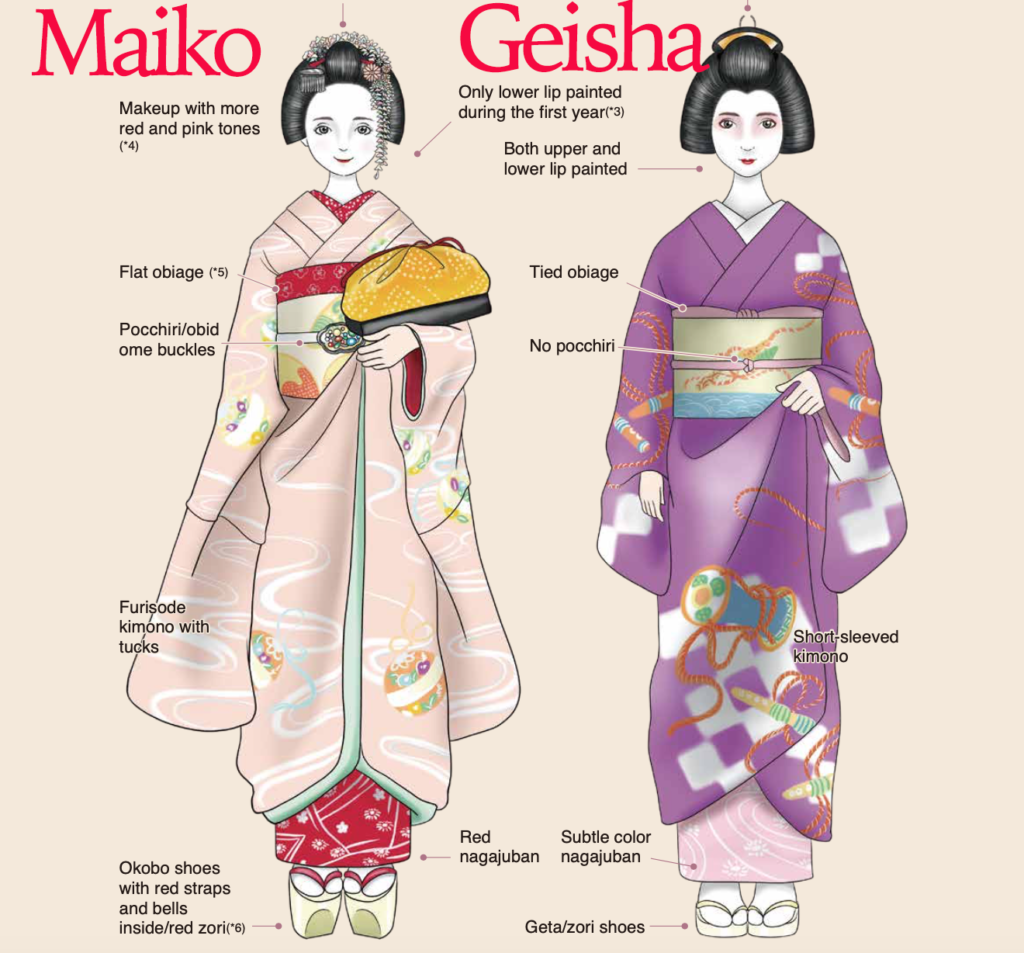What is a Maiko

A maiko (舞妓) is given to the name of the geisha apprentice. These girls undergo training in dancing, singing, and playing traditional Japanese musical instruments.
They perform during events like parties and banquets, also referred to as “ozashiki.” A maiko begins training from 15 to 20 years of age.
A maiko training includes singing kouta, dancing traditional Japanese dance, and playing the shamisen. The apprenticeship of the maiko ranges from a month to two years.
Exceptions may apply when an older maiko looks more mature to dress. In those types of circumstances, the maiko are allowed to skip some stages while still in training.
The maiko apprenticeship may vary depending on the areas of Japan. These could affect the types of training and the appearance of the maiko.
Work
A maiko studies her lessons about traditional arts in the morning. During the night, the apprentice goes to work where she sings, dances, and plays the shamisen to serve guests in exclusive teahouses, also called the ochaya.
Origin of Maiko
The origin of maiko can be traced to the Japanese women who served dumplings and green tea. The women were in teahouses. The people they served visited popular shrines in Kyoto.
The Stages
Shikomi
When these women join the profession, they are known as Shikomi (仕込み), which means “In Training.” This stage of training will last for approximately one year. During this time, the young women will take lessons in dance and music, learn how to wear kimono, and speak in Kyoto dialect known as Kyo Ben (京弁).
Once she is deemed ready to enter the profession by her teachers, she will take an exam. If she passes, then she will set a date for her official debut. The shikomi is the initial phase for adjusting to the hanamachi life and strict rules, taking basic art classes, helping at the okiya with cleaning, cooking, and other tasks.
Shikomi usually start their training at the age of 15-16, after graduating from junior high school. They can be either introduced to an okiya or contact directly via mail or phone.
Shikomi wear normal clothes during their first training. They will switch to kimono before moving to the next level.
Minarai
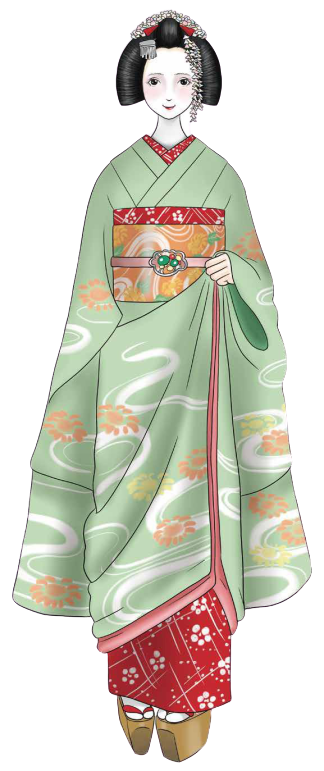
Shikomi, who passed the first stage of training, are allowed to wear the nihongami hairstyle, white makeup, and stage kimono with short obi. They accompany the geiko and maiko at banquets, and sometimes they perform simple dances.
Approximately one month before her debut, she will begin to entertain at parties wearing the heavy kimono and makeup that have become iconic symbols of the profession. However, instead of directly entertaining guests directly she will sit and watch her seniors and learn from their example. This stage is known as Minarai (見習い), which means “Learning By Observation.”
Maiko
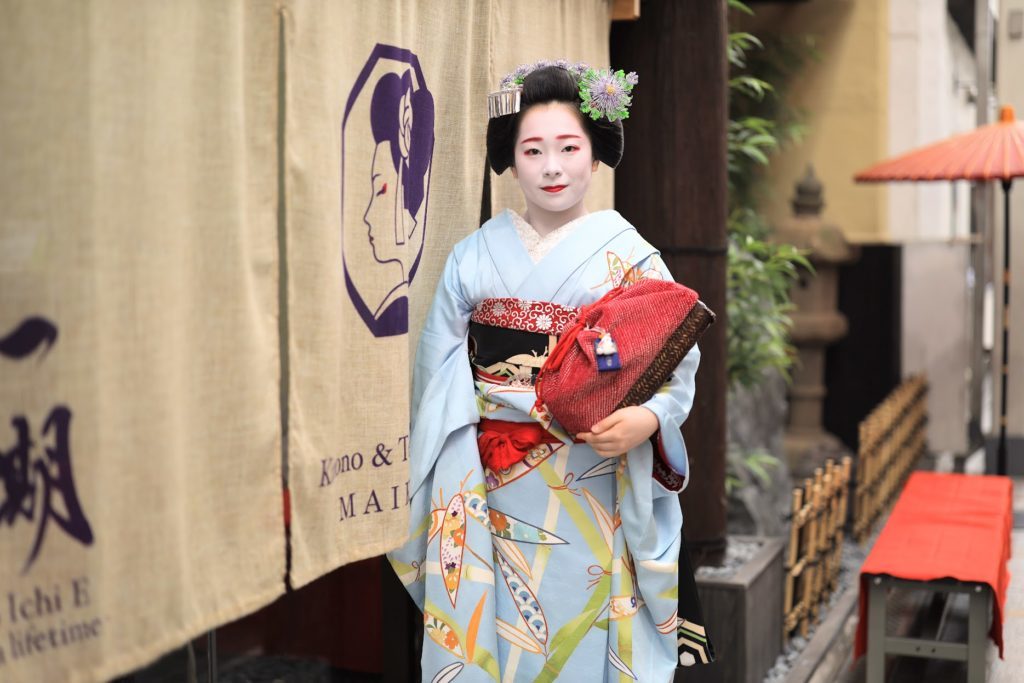
maiko in front of Maikoya Teahouse
Once that period is up, she will debut in a special ceremony known as Misedashi (見世出し), which means “Open For Business.” From this day forward, she will be a Maiko (舞妓), meaning “Woman of Dance,” and undergo an apprenticeship that lasts an average of five years.
Unlike geisha, maiko are yet untrained in the art of conversation and other formal arts, so their name reflects their limited specialization in dance. Maiko is an apprentice geisha, usually between 15 and 21 years old.
They style their hair in complicated nihongami hairstyles, wear 7-meter-long darari obi on their back, and put on long-sleeved furisode kimono. Maiko also start putting flower ornaments in their hair.
They do the same job as geiko, but they are less experienced and refined. Maiko aspire to become geiko eventually.
- Junior maiko (Usually the first years of training): During the first year, all maiko (except Pontocho maiko) paint the lower lip only and wear kanzashi with long petals hanging loosely. The appearance is a bit different: wareshinobu hairstyle, red collar, flat style of obiage.
- Senior maiko (2nd ~ 6th year of training): Senior maiko can wear a white-collar in the front and an obiage tie. Ofuku hairstyle plus additional hairstyles for special occasions, such as the katsuyama hairstyle and Yakko shimada hairstyle.
Ceremonies
Misedashi
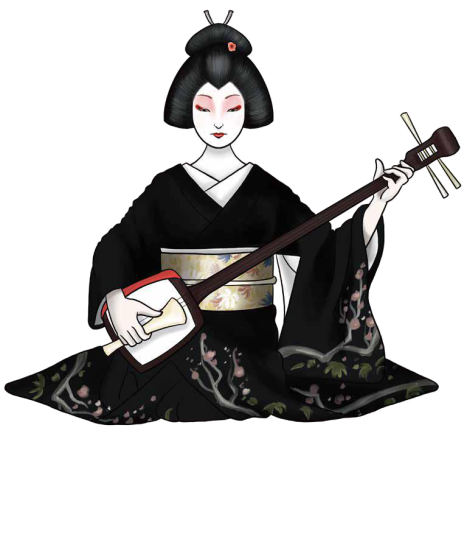
Misedashi
Misedashi is a formal debut as a maiko or geiko. In general, maiko debut under an “older sister” (more experienced geiko) who guide them through the first moments of their career.
Misedashi includes a bonding ceremony between the “sisters.” The debutant wears a formal five-crested black kimono and takes rounds at the district to greet local businesses and ask for their favor.
The debut outfit consists of a formal black kimono and gold obi. Maiko will also wear two bira-bira kanzashi in the front and a pair of miokuri kanzashi (three silver prongs) in the back of their wareshinobu hairstyle.
Erikae
The day after the ceremony, she will have her Erikae (襟替え), meaning “Turning of The Collar.” The terms refer to the different colors of kimono collars that maiko and geisha wear.
A maiko will wear a red collar with heavy white embroidery, while a geisha will wear a pure white collar with no ornamentation. From that day, she will wear more subdued outfits of a full geisha.
While rare, a woman can enter the profession at a later age, they will debut directly as a geisha instead of a maiko at the end of their one year of shikomi training.
Sakkō
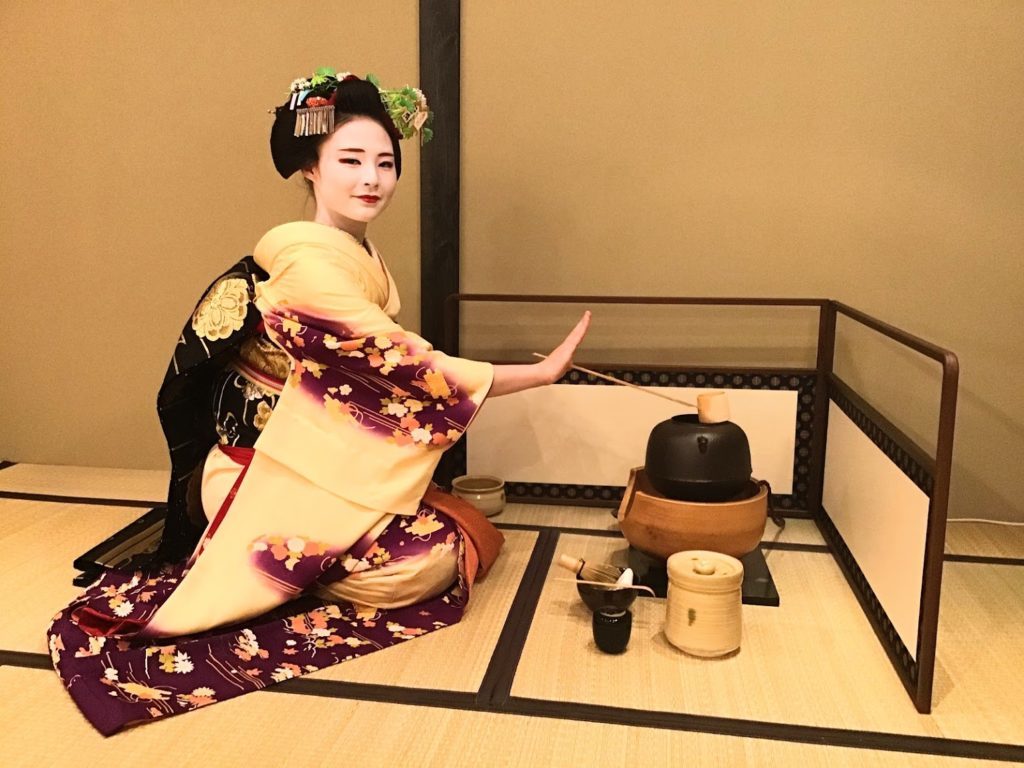
Maiko, apprentice geiko, doing Tea ceremony
Towards the end of their apprenticeship, a maiko will enter a stage known as Sakkō (先笄), named for the special sakkō hairstyle that they wear, which lasts approximately 2-4 weeks. During this time, they will wear the sakkō hairstyle as a sign that their apprenticeship is ending and that they will soon become geisha.
They will even perform a special dance named Kurokami (黒髪), meaning “Black Hair,” to show their newfound womanhood. On the final day of their apprenticeship, the maiko will take part in a special ceremony known as Danpatsu Shiki (断髪式), in which fellow maiko and geisha, along with loyal customers, will take turns clipping the wires that held her elaborate hairstyle in place. Once her hair is free she is no longer a maiko.
Skills
- Conversational Skills. Since maiko is still training, she would speak less and usually nods or smiles during a conversation. On the other hand, a geiko is an expert on initiating and maintaining a conversation in any circumstance. A geisha would know what kind of conversations make patrons feel calm, relaxed, or happy.
- Cultural Skills. Maiko would attend the dance school every day and practice shamisen playing until she perfects the skill. Geiko is a professional who can dance, play shamisen, and perform tea ceremonies. The reason that the training takes so long is that the geisha dance to different themes and songs almost every month as seasons and festivals pass by. In Kyoto, each geisha district specializes in different musical instruments and different Tea ceremony styles. So, it is not true that all geisha could play any kind of instrument.
Appearance
The outfit of a maiko is colorful and vibrant that reflects her youth and purity.
Maiko Makeup
- White Face Powder . First of all, contrary to the common belief, neither geiko nor maiko wear white makeup all the time. However, when they do, there are differences. Geiko would have a completely white face, while maiko has a little space between the hairline and white powdered skin. The reason why geiko and maiko put on the white makeup is to be seen clearly when the room is dark. This practice traces back to the past when there was no electricity yet.
- Lips. Geiko colors both of her lips red while maiko, especially junior maiko color only the lower lip red. Senior and junior maiko have different lip make up patterns.
- Red Eye Makeup. Maiko have distinctive red makeup around the eyes, while this redness is less emphasized for geiko. The red makeup around the eyes is often tied to the kabuki tradition, who often uses white, red, and black colors to be visible to the audience members who may be watching from a distance.
- Pink Blush. Maiko have some pink blush on their cheeks while the geiko do not. The idea is that maiko always look young and pure.
Makeup Steps

- The maiko prepares her skin before putting on makeup. She washes her face thoroughly and removes any products or residue. She then brushes or wets her eyebrows to make them stay flat and in shape while putting on makeup. Professional maikos use a mixture called bintsuke abura on their skin and eyebrows, so the foundation attaches better. Maikos recommend putting their hair up now to prevent it from being covered in products and spoil the flawless appearance.
- In the early times, lead was used to make white foundation or shironuri. Nowadays, white cosmetic powder or more traditional rice powder is the go-to. Kabuki oshiroi foundation packs can even now be purchased to make the foundation application process easy. Traditionally, the powder would need to be ground and mixed with water until it becomes a consistent paste. More modern ingredients mean that making the paste can be simplified. Once the white foundation paste has the correct consistency, the maiko applies it to all her facial areas. Many maikos use traditional hake brushes for this process, but cosmetic sponges work as well.

- Kona oshiroi powder is powder a maiko can apply if she wishes to. This powder smooths out the paste underneath and brings a shine to the white foundation.
- Maikos also apply the shironuri foundation to their neck, ears, upper chest, and upper back. However, one uncovered area is the nape of the neck or komata. A ‘V shape’ is left, so the maikos natural skin color is showing. The nape is considered a sensual area. The komata usually peaks out subtly once the kimono robe is worn. On special occasions, such as holidays or when a maiko becomes a geiko for the first time, a ‘W shape’ may be unpainted instead. It is seen important to show off a band of skin at the hairline that remains untouched. It symbolizes that maikos have not earned the wigs that the geiko ladies wear.
- In olden times, crushed charcoal was used in painting eyebrows. This has been replaced with eyebrow liners and pencils. Maikos should have thinner black eyebrows with a thin line of red or pink underneath. Professionals mention that coloring the eyebrows should be done carefully because if done incorrectly, all previous layers of makeup would have to be removed to start again.

- Contouring around the eyes is an important step for any makeup artist, as it is with the maiko. Modern eyeliner products are used but should be black. A maiko outlines both top and bottom areas around the eyes, from the caruncula to the outer corner. Many maiko designs have a slight ‘wing’ or flick near the outer corner.
- Afterward, red makeup is applied around the eyes. The first area is around the caruncula or the inner eye next to the nose. A small downwards flick is added to make the eyes appear larger. This flick should only be half a centimeter or so in length and is usually done with a red eyeliner or pencil. The next area around the eye is near the outer corner. A small circle of red should be drawn and colored in, either with eyeliner or eye pencil. This circle should only be a centimeter or so in diameter and should start where the middle of the iris is. This design covers both outer areas of the eyelid and underneath and eye. A simpler design is to add red eyeliner above and underneath the black lines already drawn on, starting in line with the iris.
- The use of blush sets apart the maiko from the geisha (geiko). Senior geisha prefer a more subtle look, while maiko use more pink and red in their appearance. The blush is greatly used around the cheeks. Many maiko comment that blush should be used sparingly.
- The final step is the lipstick. In ancient Japan, lipstick was first made by extracting coloring from red safflower, mixing it with water. The gloss was made with sugar crystals. Nowadays, lipstick is generally applied with a small lip brush or beni-hake.
Maiko Hairstyles

- Wig. Maiko do not wear a wig. They have to have their hair styled which costs time and money. Maiko often sleep on a piece of wood (takamakura) at night to keep their hairstyle for a few days.
- Maiko Hair. One of the biggest differences between a maiko and geiko is the hairstyle. Maiko have the wareshinobu hairstyle, while geiko have the shimada hairstyle. Senior and junior maiko have different hairstyles. Maiko wear colorful hair ornaments with flower motifs which change every month.
- Hairpins. Maiko wears silver dangling metal hair pins called bira.
Maiko Outfit
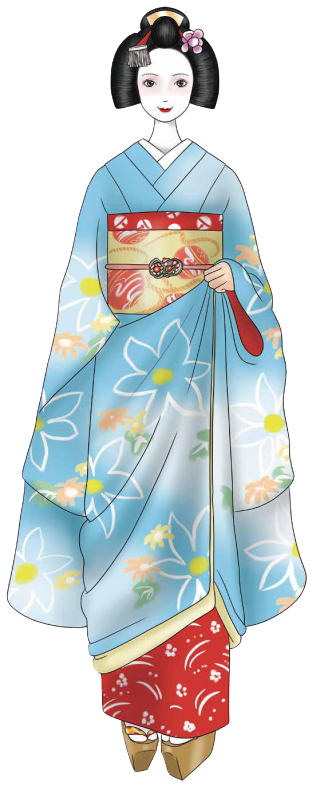
- Kimono. Maiko wear a colorful, usually flower-decorated, kimono with long sleeves, while geiko wear a simple kimono with short sleeves. The innerwear of maiko and geiko are also different. To emphasize the young age and purity of maiko usually the chest of maiko is suppressed. Both maiko and geiko wear expensive silk kimonos that are always tailor-made and not sold in stores. One of the main differences between maiko and geiko is the color of the collar they wear. Maiko wear a red collar, while geiko wear a white-collar. That is why, when a maiko becomes a professional geiko, they use the term “turning the collar.” Read More about the kimono of maiko and geisha.
- Sash (Obi). Maiko wear a long silk sash that is 5~7 meters long. The outfit can be as heavy as 15 kilos in the winter with the long sash, the complicated innerwear, and the jacket.
- Sandals. Maiko wear tall sandals called okobo. The sandals usually have a bell in place that makes a sound when they move. The bell sounds are called The Sound of Kyoto Streets by the locals.
Maikoya Kimono Tea Ceremony
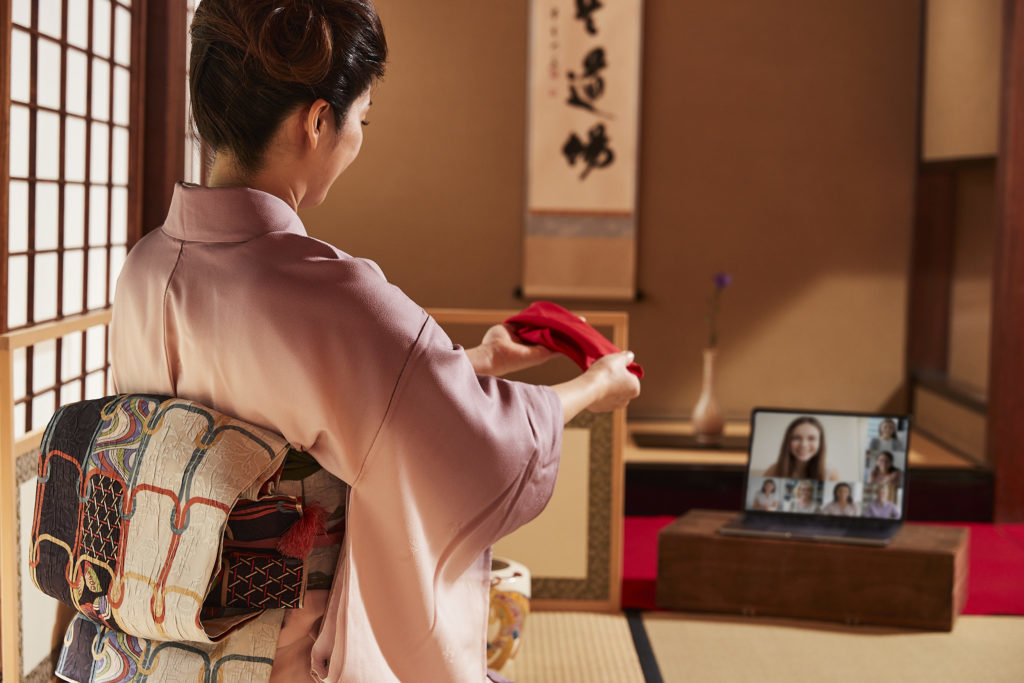
Online Tea ceremony Virtual Tea Class
Maikoya is one of Japan’s leading cultural experience providers with branches in Osaka, Kyoto, and Tokyo. The company specializes in cultural and traditional activities such as Tea ceremony, sushi and other cooking classes, calligraphy, flower arrangement, taiko drumming, and the like.
Maikoya accommodates sessions in English, Chinese, and Japanese. The activities are designed to accommodate groups for school trips, company trips, international conferences, vacationers, and other miscellaneous companies.
Maikoya is also the only venue that offers geisha tea ceremony experience everyday in central Kyoto. The geisha tea ceremony also includes sweets tasting, wearing a traditional kimono and asking questions to the geisha. Maikoya also organizes shamisen lessons for large groups on demand. Please contact Maikoya to arrange a shamisen lesson today.
Contact us : info@mai-ko.com

